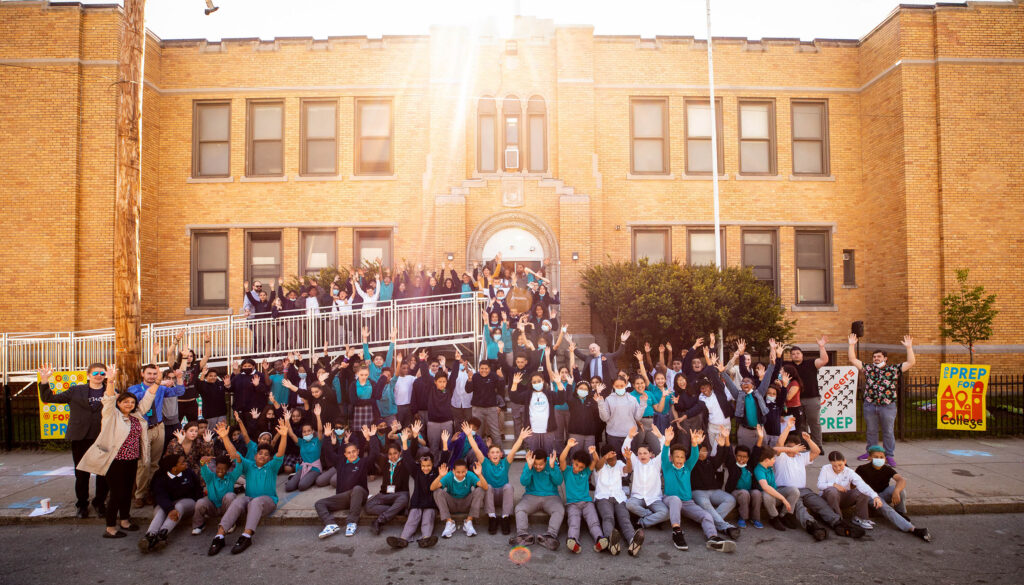PVD Prep Charter School on Harrison Street in Providence ranked #1 among middle schools in the city in math and science and #3 in English Language Arts for fifth and sixth graders during its first year, 2021-2022. The school added seventh grade last year and eighth grade this year and now enrolls 252 students. (Jo Sittenfeld)
Charter schools perform comparatively well to public school districts, so why are they being punished financially?
Imagine what Rhode Island’s public charter schools could do if they got the same amount of state money per pupil as public districts schools do.
Do the math, courtesy of data from the Rhode Island Public Expenditure Council (RIPEC). Its recent report found that charter public schools had per pupil expenditures (PPE) that were 16.4% lower than the state’s overall average PPE of $17,983.
State government is 100% responsible for this. For all the lip service paid to “equity,” public agencies and political offices commit flagrant discrimination.
Discrimination against whom? Taken together, 71.1% of charter students come from low-income families, as compared with 47.8% of public school enrollment overall. Overwhelmingly, charters educate low-income kids.
Parents send their kids to charters for their smaller class sizes, calmer atmospheres, stronger attention to the kids’ well being, and because they generally outperform their “sending districts,” where the kids would otherwise have gone to school. In English Language Arts, 42.2% of charter students were proficient, compared to 38.3% in sending-district students. Math was worse: 38.3% proficient in charters; 29.4% in district schools.
The 16.4% discrepancy RIPEC cited is probably much more when you include other nonsense like deeming charters ineligible for federal grants like the $4.8 million federal Bipartisan Safer Schools Community Act.
The sins of the state are bundled in so much red tape, you’ll need RIPEC’s scrupulously-researched report to understand the many details and caveats of the following three big issues:
- Rhode Island’s funding formula is calculated using a small “market basket” of educational necessities. A formula takes into account each district’s challenges and ability to raise the money for their share. Challenges like poverty get a formulaic extra to arrive at an adjusted PPE for each district. The state pays its share from general funds, while cities or towns use locally-raised taxes. State and local together add up to the “adjusted” PPE.
Since 2017, all sending districts keep at least 7.0% of what they owe to the charters. These dollars are for “unique costs,” a long list of services and categories few of which make sense. For example, charters pay, in part, for
- The vast unfunded state retiree health care costs – which charters didn’t create.
- Career and technical tuition and transportation costs – as if the Nurses Institute weren’t itself a CTE school. Why should a charter contribute to another school’s tuition?
- Debt service and rent for district buildings.
All districts take their 7%, even if the district couldn’t justify such expenses. Some districts itemize their unique costs to charge an even higher percentage.
- The state exacerbates inequity with its housing aid, which are construction funds usually for specific projects. All districts get at least 35% reimbursement for their “housing.” Low-income districts receive up to 80%. Charters max out at 30% no matter who’s in their schools.
Charters received only 45% of allocations from a 2018 housing bond, but sending districts received a minimum of 52% and many got much more.
Mind you, towns own district school buildings. Charters must raise the money to rent or buy, retrofit to comply with fire codes and continue to maintain theirs with their reduced ppe. Charters do not have the luxury of deferring maintenance because the upkeep of their facility factors into the onerous and expensive charter-school accountability system – from which districts are exempt.
- “Transitional funding” is the practice of reimbursing districts for kids who leave for charters. The rationale is that since district structures are so rigid, they can’t adjust nimbly to reduced enrollment. But ossified school governance is a huge problem that should be solved, not coddled.
Student enrollment has dropped so dramatically in some districts that some schools closed. But for this year and next, districts will be “held harmless” by using the highest enrollment number of the last three years subtracting the number of current students to determine how many are missing. For each missing kid, districts get 40% of the PPE this year and 25% the next. They’ll keep the inflated enrollment until 2026 when they’ll shift to the true school population.
Other issues abound, but those funding streams are the biggies.
The plucky charters perform rather well, considering their students have each been denied a big chunk of their PPE.
So imagine what charters could achieve if state officials were willing to make good on “equity.” Imagine bucking the special interests whose schools benefit financially from denying poor students access to a desirable and fairly-funded public school. Imagine how attractive the Rhode Island workforce might become if charters got a fair break, and districts felt compelled to learn from them.
On the whole, charters are a bright spot in our sad educational landscape. Stop punishing their kids.
First published: RI Current News, September 21, 2023
Public comments posted on this site are much appreciated. However, if you prefer: juliasteiny@gmail.com
